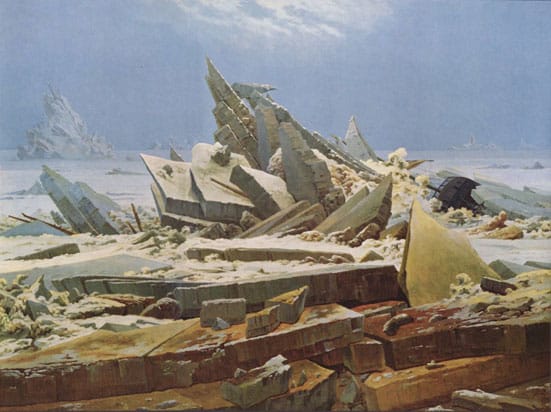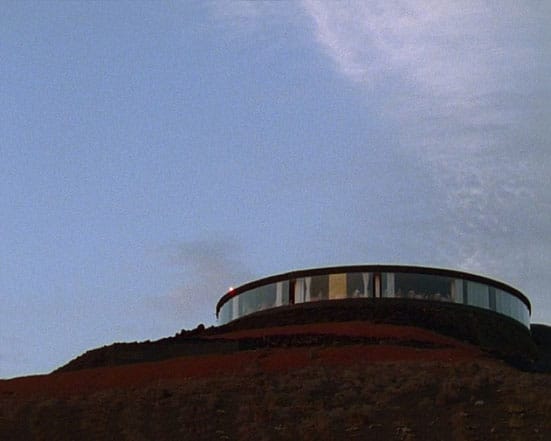Geographic authenticity has never really had a place in mainstream cinema. Whether constructing a phony jungle canopy in a soundstage, or passing off one barren desert-scape for another, cinema has always dressed its geographies; shrouded them in filters, stacked them with sets, peopled them with extras. Herzog's favourite clime, the tropical rainforest, rustles with conquistadors and Viet-Nam POWs; temporally bent and arrested by the invasive movie set. The vast Comancheria and the Staked Plains of southern USA lend their existential colosseum to the archetypal western - and to some of the more barren planets of Star Trek - their teetering rock formations providing equal legitimacy to alien life as that of the wild frontier. Both of these genre conventions (the western and sci-fi) require the myriad connotations of hostility, the alien, inhospitality, and the exotic in order to fulfill their manipulative remit. Plainly, the most popular locations for genre filmmaking are capable of levelling - through convention - the audience's interpretative idiosyncrasies; by casting the most familiarly connoted locations at the film's heart, the audience might expect the subject of the film to trace the contours of the landscape; to tread its well established paths - to interact with the environment in familiar ways. The fictional-cultural history of a natural environment is, often, totally divorced from its actual, documentary history. New Zealand's tourist industry has increased exponentially over the past few years, entirely due to Peter Jackson's decision to film the majority of 'The Lord of The Rings' trilogy in his home country's remarkably diverse landscape. The verdant dales of Matamata were transformed into pastoral Hobbiton; Mount Ruapehu became Mount Doom - a miraculous sleight of hand morphing millions of years of geological process into a palpable Middle Earth in an instant; and, in reverse, the inadequacy and mundanity of proclaiming Middle Earth as New Zealand. Imagine a landscape so cinematic, so ingrained in the connotative repertoire as to be unlivable - a place where the visitor/audience member can no longer rest anywhere without conjuring the fatalism and mythos of narrative filmmaking. Disney World closes the gap between the 'truth' of a landscape, and its perceived narcissism: the short-circuit between - and the subsequent fusion of - connotation and denotation.
Graham Ellard and Stephen Johnstone's 2007 film, 'Proposal for an unmade film (set in the future)', is shot on the island of Lanzarote in the Canaries. Seemingly billed and shot as a reccie for a potential sci-fi film, the film is complicated by its documentary-like honesty towards the history of the landscape and the architecture it houses (designed by César Manrique). Neither, sci-fi nor documentary is allowed to hold sway, but rather the film combines the languages of both to create a complex stratum of denied signs and evaded expectations.
Lanzarote's cinematic history is extremely prodigious, due in no small part to its inhospitable, primal landscape: black sands shift around cerulean lagoons; volcanic fissures vent sulphurous steam; Mars-red lava-flows hardened into treacherous planes - all punctuated with Marique's most extraordinarily 'retro-futurist' architecture. Somehow echoing Walt Disney's vision of a land of capital, regulated fantasy - Manrique's unparalleled control over the architectural planning of the island stemmed from a vision of a potential and sustainable tourist industry, only here, unlike in Disneyland, attuned to the environment, but in such a way as to suppress or fold history, and superimpose a new meaning on the landscape. The terrain, particularly the Timonfaya National Park, has provided the backdrop for any number of fantasy films ('One million years BC', 'When dinosaurs ruled the earth', 'Journey to the centre of the earth', and 'Enemy mine' to name a few), while Manrique's architecture has inspired the extravagant sets of the H.Q.s of the archetypal Bond villain. This fantastical history as lived through cinema (perhaps uniquely on Lanzarote), provides a fictional timeline of the island's human development - from cavemen battling dinosaurs beside its brilliant lagoons, to a future alien war fought on its desolate shores. It is through this fictionalising of history - and particularly a geocentric, extra-human history - that the landscape is reworked to the whim of humanity via the film set.
To a similar end, artist William Gilpin's eighteenth century notion of the picturesque altered the landscape of the earth forever; aestheticising what was previously land to be tilled, traversed or bartered; empathizing and anthropomorphizing the environment. With the advent of concepts such as leisure in the eighteenth century, an audience for the landscape was created, this spelled the beginning of a convention of the landscape as stage for the roving holidaymaker. But it was only with the Romantics that the connotative potential of the natural vista was embedded in the cultural palette of Europe - one need only think of Caspar David Friedrich's tormented seas, shattered ice floes and scuppered ships to perceive the apparent emotional absorbency of nature. Cinema, with its ability to vitalize, through movement, humanity's indexical relationship with the soil beneath its feet, completed the planet's transformation from practicable homestead to dramatic scenario.
EA

Caspar David Friedrich, 'The Sea of Ice' (1824) Still from Star Trek - from 'Arena', shot at Vasquez Rocks in California.

Still from 'Proposal for an unmade film (set in the future)', Graham Ellard & Stephen Johnstone (UK, 2007, 21:00 mins).